Microstructural Investigation of Variscan Late-Collisional Granitoids (Asinara Island, NW Sardinia, Italy): New Insights on the Relationship Between Regional Deformation and Magma Emplacement
Abstract
1. Introduction
2. Geological Setting
2.1. Regional Geology
2.2. Magmatism of Corsica–Sardinia Batholith
3. Materials and Methods
4. Magmatic Rocks of Asinara Island
4.1. Field and Petrographic Description
4.1.1. Castellaccio Intrusive Unit
4.1.2. Punta Sabina Intrusive Unit
4.1.3. Sheeted Dyke Complex
4.2. Microstructural Data
4.2.1. Castellaccio Intrusive Unit

4.2.2. Punta Sabina Intrusive Unit
4.2.3. Sheeted Dyke Complex
5. Discussion
6. Conclusions
Author Contributions
Funding
Data Availability Statement
Acknowledgments
Conflicts of Interest
References
- Paterson, S.R.; Fowler, T.K. Extensional pluton-emplacement models: Do they work for large plutonic complexes? Geology 1993, 21, 781–784. [Google Scholar] [CrossRef]
- Román-Berdiel, T. Geometry of granite emplacement in the upper crust: Contributions of analogue modelling. Geol. Soc. Spec. Publ. 1999, 168, 77–94. [Google Scholar] [CrossRef]
- Corti, G.; Bonini, M.; Conticelli, S.; Innocenti, F.; Manetti, P.; Sokoutis, D. Analogue modelling of continental extension: A review focused on the relations between the patterns of deformation and the presence of magma. Earth-Sci. Rev. 2003, 63, 169–247. [Google Scholar] [CrossRef]
- Dini, A.; Westerman, D.S.; Innocenti, F.; Rocchi, S. Magma emplacement in a transfer zone: The Miocene mafic Orano dyke swarm of Elba Island, Tuscany, Italy. Geol. Soc. Spec. Publ. 2008, 302, 131–148. [Google Scholar] [CrossRef]
- Tack, L.; Wingate, M.T.D.; De Waele, B.; Meert, J.; Belousova, E.; Griffin, B.; Tahon, A.; Fernandez-Alonso, M. The 1375 Ma “Kibaran event” in Central Africa: Prominent emplacement of bimodal magmatism under extensional regime. Precambrian Res. 2010, 180, 63–84. [Google Scholar] [CrossRef]
- Vezzoni, S.; Rocchi, S.; Dini, A. Lateral extrusion of a thermally weakened pluton overburden (Campiglia Marittima, Tuscany). Int. J. Earth Sci. (Geol. Rundsch.) 2017, 107, 1343–1355. [Google Scholar] [CrossRef]
- Brogi, A.; Caggianelli, A.; Liotta, D.; Zucchi, M.; Spina, A.; Capezzuoli, E.; Casini, A.; Buracchi, E. The Gavorrano monzogranite (Northern Apennines): An updated review of host rock protoliths, thermal metamorphism and tectonic setting. Geosciences 2021, 11, 124. [Google Scholar] [CrossRef]
- Collins, W.J.; Sawyer, W. Pervasive granitoid magma transfer through the lower–middle crust during non-coaxial compressional deformation. J. Metamorph. Geol. 1996, 14, 565–579. [Google Scholar] [CrossRef]
- Hutton, D.H.W. Syntectonic Granites and the Principle of Effective Stress: A General Solution to the Space Problem? In Granite: From Segregation of Melt to Emplacement Fabrics, Petrology and Structural Geology; Bouchez, J.L., Hutton, D.H.W., Stephens, W.E., Eds.; Springer: Dordrecht, 1997; Volume 8, pp. 189–197. [Google Scholar] [CrossRef]
- Kalakay, T.J.; John, B.E.; Lageson, D.R. Fault-controlled pluton emplacement in the Sevier fold-and-thrust belt of southwest Montana, USA. J. Struct. Geol. 2001, 23, 1151–1165. [Google Scholar] [CrossRef]
- Tibaldi, A. Volcanism in compressional tectonic settings: It is possible? Geophys. Res. Lett. 2005, 32, L06309. [Google Scholar] [CrossRef]
- Galland, O.; Cobbold, P.R.; de Bremond d’Ars, J.; Hallot, E. Rise and emplacement of magma during horizontal shortening of the brittle crust: Insights from experimental modelling. J. Geophys. Res. 2007, 112, B06402. [Google Scholar] [CrossRef]
- Galland, O.; Hallot, E.; Cobbold, P.R.; Ruffet, G.; de Bremond d’Ars, J. Volcanism in compressional Andean setting: A structural and geochronological study of Tromen volcano (Nequén province, Argentina). Tectonics 2007, 26, TC4010. [Google Scholar] [CrossRef]
- Mazzarini, F.; Fornaciai, A.; Bistacchi, A.; Pasquarè, F.A. Fissural volcanism, polygenetic volcanic fields, and crustal thickness in the Payen Volcanic Complex on the central Andes foreland (Mendoza, Argentina). Geochem. Geophys. Geosyst. 2008, 9, Q09002. [Google Scholar] [CrossRef]
- D’Lemos, R.S.; Brown, M.; Strachan, R.A. Granite magma generation, ascent and emplacement within a transpressional orogen. J. Geol. Soc. Lond. 1992, 149, 487–496. [Google Scholar] [CrossRef]
- Hutton, D.H.W.; Reavy, R.S. Strike-slip tectonics and granite petrogenesis. Tectonics 1992, 11, 960–967. [Google Scholar] [CrossRef]
- Brown, M. The generation, segregation, ascent and emplacement of granite magma. Earth-Sci. Rev. 1994, 36, 83–130. [Google Scholar] [CrossRef]
- Vigneresse, J.L. Control of granite emplacement by regional deformation. Tectonophysics 1995, 249, 173–186. [Google Scholar] [CrossRef]
- Román-Berdiel, T.; Gapais, D.; Brun, J.P. Granite intrusion along strike-slip zones in experiment and nature. Am. J. Sci. 1997, 297, 651–678. [Google Scholar] [CrossRef]
- Salvini, F.; Brancolini, G.; Busetti, M.; Storti, F.; Mazzarini, F.; Coren, F. Cenozoic geodynamics of the Ross Sea region, Antarctica: Crustal extension, intraplate strike-slip faulting, and tectonic inheritance. J. Geophys. Res. 1997, 102, 24669–24696. [Google Scholar] [CrossRef]
- Rosenberg, C.L. Shear zones and magma ascent: A model based on a review of the Tertiary magmatism in the Alps. Tectonics 2004, 23, TC2003. [Google Scholar] [CrossRef]
- Liotta, D.; Festa, V.; Caggianelli, A.; Prosser, G.; Pascazio, A. Mid-crustal shear zone evolution in a syn-tectonic late Hercynian granitoid (Sila Massif, Calabria, southern Italy). Int. J. Earth. Sci. (Geol. Rundsch.) 2004, 93, 400–413. [Google Scholar] [CrossRef]
- Corti, G.; Moratti, G.; Sani, F. Relations between surface faulting and granite intrusions in analogue models of strike-slip deformation. J. Struct. Geol. 2005, 27, 1547–1562. [Google Scholar] [CrossRef]
- Boutonnet, E.; Leloup, P.H.; Arnaud, N.; Paquette, J.-L.; Davis, W.J.; Hattori, K. Synkinematic magmatism, heterogeneous deformation, and progressive strain localization in a strike-slip shear zone: The case of the right-lateral Karakorum fault. Tectonics 2012, 31, TC4012. [Google Scholar] [CrossRef]
- Vezzoni, S.; Biagioni, C.; D’Orazio, M.; Pieruccioni, D.; Galanti, Y.; Petrelli, M.; Molli, G. Evidence of Permian magmatism in the Alpi Apuane metamorphic complex (Northern Apennines, Italy): New hints for the geological evolution of the basement of the Adria plate. Lithos 2018, 318–319, 104–123. [Google Scholar] [CrossRef]
- Vieira, D.T.; Koester, E.; Ramos, R.C.; Porcher, C.C.; D’Ávila Fernandes, L.A. SHRIMP U-Pb zircon ages for the synkinematic magmatism in the Dorsal de Canguçu Transcurrent Shear Zone, Dom Feliciano Belt (Brazil): Tectonic implications. J. South Am. Earth Sci. 2020, 100, 102603. [Google Scholar] [CrossRef]
- Román-Berdiel, T.; Gapais, D.; Burg, J.P. Analogue models of laccolith formation. J. Struct. Geol. 1995, 17, 1337–1346. [Google Scholar] [CrossRef]
- Petford, N.; Cruden, A.R.; McCaffrey, K.J.W.; Vigneresse, J.L. Granite magma formation, transport and emplacement in the Earth’s crust. Nature 2000, 408, 669–673. [Google Scholar] [CrossRef]
- Kavanagh, J.L.; Menand, T.; Sparks, R.S.J. An experimental investigation of sill formation and propagation in layered elastic media. Earth Planet. Sci. Lett. 2006, 245, 799–813. [Google Scholar] [CrossRef]
- Mazzarini, F.; Musumeci, G.; Montanari, D.; Corti, G. Relations between deformation and upper crustal magma emplacement in laboratory physical models. Tectonophysics 2010, 484, 139–146. [Google Scholar] [CrossRef]
- Beaumont, C.; Jamieson, R.; Nguyen, M. Models of large, hot orogens containing a collage of reworked and accreted terranes. Can. J. Earth Sci. 2010, 47, 485–515. [Google Scholar] [CrossRef]
- Butler, R.W.H.; Harris, N.B.W.; Whittington, A.G. Interactions between deformation, magmatism and hydrothermal activity during active crustal thickening: A field example from Nanga Parbat, Pakistan Himalayas. Mineral. Mag. 1997, 61, 37–52. [Google Scholar] [CrossRef]
- Paterson, S.R.; Tobisch, O.T. Using pluton ages to date regional deformations: Problems with commonly used criteria. Geology 1988, 16, 1108–1111. [Google Scholar] [CrossRef]
- Evans, N.G.; Gleizes, G.; Leblanc, D.; Bouchez, J.L. Syntectonic emplacement of the Maladeta granite (Pyrenees) deduced from relationships between Hercynian deformation and contact metamorphism. J. Geol. Soc. Lond. 1998, 155, 209–216. [Google Scholar] [CrossRef]
- Vezzoni, S.; Pieruccioni, D.; Galanti, Y.; Biagioni, C.; Dini, A. Permian hydrothermal alteration preserved in polymetamorphic basement and constraints for ore-genesis (Alpi Apuane, Italy). Geosciences 2020, 10, 399. [Google Scholar] [CrossRef]
- Casini, L.; Maino, M.; Langone, A.; Oggiano, G.; Corvò, S.; Estrada, J.R.; Liesa, M. HTLP metamorphism and fluid-fluxed melting during multistage anatexis of continental crust (N Sardinia, Italy). J. Metamorph. Geol. 2023, 41, 25–57. [Google Scholar] [CrossRef]
- Gleizes, G.; Leblanc, D.; Olivier, P.; Bouchez, J. Strain partitioning in a pluton during emplacement in transpressional regime: The example of the Néouvielle granite (Pyrenees). Int. J. Earth Sci. 2001, 90, 325–340. [Google Scholar] [CrossRef]
- Pawley, M.J.; Collins, W.J. The development of contrasting structures during the cooling and crystallisation of a syn-kinematic pluton. J. Struct. Geol. 2002, 24, 469–483. [Google Scholar] [CrossRef]
- Gloaguen, E.; Branquet, Y.; Chauvet, A.; Bouchot, B.; Barbanson, L.; Vigneresse, J.-L. Tracing the magmatic/hydrothermal transition in regional low-strain zones: The role of magma dynamics in strain localization at pluton roof, implications for intrusion-related gold deposits. J. Struct. Geol. 2014, 58, 108–121. [Google Scholar] [CrossRef]
- Ludovic, A.M.; Maurice, K.; Martial, F.E.; Jules, T.K.; Julios, E.A.; Cliff, C.K.S.; Belmien, S.Y.R.; Blandine, K.T.A.; Lauraine, A.F. Field observations and microstructural evidence of syntectonic emplacement of the Ngwi granitic plutons (central Cameroon domain). Arab. J. Geosci. 2021, 14, 1497. [Google Scholar] [CrossRef]
- de Luchi, M.G.L.; Rapalini, A.E.; Tomezzoli, R.N. Magnetic fabric and microstructures of Late Paleozoic granitoids from the North Patagonian Massif: Evidence of a collision between Patagonia and Gondwana? Tectonophysics 2010, 494, 118–137. [Google Scholar] [CrossRef]
- Bouchez, J.L.; Gleizes, G.; Djouadi, T.; Rochette, P. Microstructure and magnetic susceptibility applied to emplacement kinematics of granites: The example of the Foix pluton (French Pyrenees). Tectonophysics 1990, 184, 157–171. [Google Scholar] [CrossRef]
- Vernon, R.H.; Johnson, S.E.; Melis, E.A. Emplacement-related microstructures in the margin of a deformed pluton: The San José tonalite, Baja California, México. J. Struct. Geol. 2004, 26, 1867–1884. [Google Scholar] [CrossRef]
- Casini, L.; Cuccuru, S.; Maino, M.; Oggiano, G.; Tiepolo, M. Emplacement of the Arzachena Pluton (Corsica–Sardinia Batholith) and the geodynamics of incoming Pangaea. Tectonophysics 2012, 544–545, 31–49. [Google Scholar] [CrossRef]
- Secchi, F.; Casini, L.; Cifelli, F.; Naitza, S.; Carta, E.; Oggiano, G. Syntectonic magmatism and reactivation of collisional structures during late-Variscan shearing (SW Sardinia, Italy). Int. J. Earth Sci. (Geol. Rundsch.) 2022, 111, 1469–1490. [Google Scholar] [CrossRef]
- Castro, A. On granitoid emplacement and related structures. A review. Geol. Rundsch. 1987, 76, 101–124. [Google Scholar] [CrossRef]
- Fazio, E.; Fiannacca, P.; Russo, D.; Cirrincione, R. Submagmatic to solid-state deformation microstructures recorded in cooling granitoids during exhumation of Late-Variscan crust in North-Eastern Sicily. Geosciences 2020, 10, 311. [Google Scholar] [CrossRef]
- Fiannacca, P.; Russo, D.; Fazio, E.; Cirrincione, R.; Mamtani, M.A. Fabric analysis in upper crustal post-collisional granitoids from the Serre Batholith (Southern Italy): Results from microstructural and AMS investigations. Geosciences 2021, 11, 414. [Google Scholar] [CrossRef]
- Cappelli, B.; Carmignani, L.; Castorina, F.; Di Pisa, A.; Oggiano, G.; Petrini, R. A Hercynian suture zone in Sardinia: Geological and geochemical evidence. Geodin. Acta 1992, 5, 101–118. [Google Scholar] [CrossRef]
- Carmignani, L.; Carosi, R.; Di Pisa, A.; Gattiglio, M.; Musumeci, G.; Oggiano, G.; Pertusati, P.C. The Hercynian chain in Sardinia (Italy). Geodin. Acta 1994, 7, 31–47. [Google Scholar] [CrossRef]
- Carosi, R.; Palmeri, R. Orogen-parallel tectonic transport in the Variscan belt of northeastern Sardinia (Italy): Implications for the exhumation of medium-pressure metamorphic rocks. Geol. Mag. 2002, 139, 497–511. [Google Scholar] [CrossRef]
- Franke, W. Tectonostratigraphic units in the Variscan belt of central Europe. Geol. Soc. Am. Spec. Pap. 1989, 67–90. [Google Scholar] [CrossRef]
- Matte, P. The Variscan collage and orogeny (480–290 Ma) and the tectonic definition of the Armorica microplate: A review. Terra Nova 2001, 13, 122–128. [Google Scholar] [CrossRef]
- Stampfli, G.M.; Hochard, C.; Vérard, C.; Wilhem, C.; von Raumer, J. The formation of Pangea. Tectonophysics 2013, 593, 1–19. [Google Scholar] [CrossRef]
- Domeier, M.; Torsvik, T.H. Plate tectonics in the late Paleozoic. Geosci. Front. 2014, 5, 303–350. [Google Scholar] [CrossRef]
- von Raumer, J.F.; Busy, F.; Schaltegger, U.; Schulz, B.; Stampfli, G.M. Pre-Mesozoic Alpine basements—Their place in the European Paleozoic framework. Geol. Soc. Am. Bull. 2013, 125, 89–108. [Google Scholar] [CrossRef]
- Carosi, R.; Frassi, C.; Montomoli, C. Deformation during exhumation of medium- and high-grade metamorphic rocks in the Variscan chain in northern Sardinia (Italy). Geol. J. 2009, 44, 280–305. [Google Scholar] [CrossRef]
- Carosi, R.; Petroccia, A.; Iaccarino, S.; Simonetti, M.; Langone, A.; Montomoli, C. Kinematics and timing constraints in a transpressive tectonic regime: The example of the Posada-Asinara Shear Zone (NE Sardinia, Italy). Geosciences 2020, 10, 288. [Google Scholar] [CrossRef]
- Cruciani, G.; Montomoli, C.; Carosi, R.; Franceschelli, M.; Puxeddu, M. Continental collision from two perspectives: A review of Variscan metamorphism and deformation in northern Sardinia. Per. Min. 2015, 84, 657–699. [Google Scholar] [CrossRef]
- Cocco, F.; Funedda, A. Mechanical influence of inherited folds in thrust development: A case study from the Variscan fold-and-thrust belt in SW Sardinia (Italy). Geosciences 2021, 11, 276. [Google Scholar] [CrossRef]
- Casini, L.; Funedda, A.; Oggiano, G. A balanced foreland–hinterland deformation model for the Southern Variscan belt of Sardinia, Italy. Geol. J. 2010, 45, 634–649. [Google Scholar] [CrossRef]
- Cocco, F.; Oggiano, G.; Funedda, A.; Loi, A.; Casini, L. Stratigraphic, magmatic and structural features of Ordovician tectonics in Sardinia (Italy): A review. J. Iber. Geol. 2018, 44, 619–639. [Google Scholar] [CrossRef]
- Petroccia, A.; Forshaw, J.B.; Lanari, P.; Iaccarino, S.; Montomoli, C.; Carosi, R. Pressure and temperature estimation in greenschist-facies metapelites: An example from the Variscan Belt in Sardinia. J. Metamorph. Geol. 2025, 43, 21–46. [Google Scholar] [CrossRef]
- Giacomini, F.; Bomparola, R.M.; Ghezzo, C.; Guldbransen, H. The geodynamic evolution of the Southern European Variscides: Constraints from the U/Pb geochronology and geochemistry of the lower Palaeozoic magmatic-sedimentary sequences of Sardinia (Italy). Contrib. Mineral. Petrol. 2006, 152, 19–42. [Google Scholar] [CrossRef]
- Elter, F.M.; Musumeci, G.; Pertusati, P.C. Late Hercynian shear zones in Sardinia. Tectonophysics 1990, 176, 387–404. [Google Scholar] [CrossRef]
- Iacopini, D.; Carosi, R.; Montomoli, C.; Passchier, C.W. Strain analysis and vorticity of flow in the Northern Sardinian Variscan Belt: Recognition of a partitioned oblique deformation event. Tectonophysics 2008, 446, 77–96. [Google Scholar] [CrossRef]
- Carosi, R.; Montomoli, C.; Iaccarino, S.; Benetti, B.; Petroccia, A.; Simonetti, M. Constraining the timing of evolution of shear zones in two collisional orogens: Fusing structural geology and geochronology. Geosciences 2022, 12, 231. [Google Scholar] [CrossRef]
- Carosi, R.; Di Pisa, A.; Iacopini, D.; Montomoli, C.; Oggiano, G. The structural evolution of the Asinara Island (NW Sardinia, Italy). Geodin. Acta 2004, 17, 309–329. [Google Scholar] [CrossRef]
- Franceschelli, M.; Puxeddu, M.; Cruciani, G. Variscan metamorphism in Sardinia, Italy: Review and discussion. J. Virtual Explor. 2005, 19, 2. [Google Scholar] [CrossRef]
- Franceschelli, M.; Memmi, I.; Pannuti, F.; Ricci, C.A. Diachronous metamorphic equilibria in the Hercynian basement of northern Sardinia, Italy. Geol. Soc. Spec. Publ. 1989, 43, 371–375. [Google Scholar] [CrossRef]
- Di Pisa, A.; Oggiano, G.; Talarico, F. Post collisional tectono-metamorphic evolution in the axial zone of the Hercynian belt in Sardinia: The example from the Asinara island. Doc. B.R.G.M. 1993, 219, 216–217. [Google Scholar]
- Strada, E.; Talarico, F.M.; Florindo, F. Magnetic petrology of variably retrogressed eclogites and amphibolites: A case study from the Hercynian basement of northern Sardinia (Italy). J. Geophys. Res. 2006, 111, B12S26. [Google Scholar] [CrossRef]
- Carosi, R.; Montomoli, C.M.; Iacopini, D.; Petroccia, A.; Simonetti, M.; Oggiano, G. Geology of the Asinara Island (Sardinia, Italy). J. Maps 2024, 20, 2317136. [Google Scholar] [CrossRef]
- Simonetti, M.; Pieruccioni, D.; Carosi, R.; Montomoli, C.; Iaccarino, S.; Zucchi, M. A review of criteria, methods, and standards for mapping crystalline terrains: Integrating field geology and analytical data. Ital. J. Geosci. 2024, 143, 426–454. [Google Scholar] [CrossRef]
- Cruciani, G.; Franceschelli, M.; Massonne, H.J.; Carosi, R.; Montomoli, C. Pressure–temperature and deformational evolution of high-pressure metapelites from Variscan NE Sardinia, Italy. Lithos 2013, 175–176, 272–284. [Google Scholar] [CrossRef]
- Cruciani, G.; Franceschelli, M.; Carosi, R.; Montomoli, C. P-T path from garnet zoning in pelitic schist from NE Sardinia, Italy: Further constraints on the metamorphic and tectonic evolution of the north Sardinia Variscan belt. Lithos 2022, 428–429, 106836. [Google Scholar] [CrossRef]
- Di Vincenzo, G.; Carosi, R.; Palmeri, R. The relationship between tectono-metamorphic evolution and Argon isotope records in white mica: Constraints from in situ 40Ar-39Ar laser analysis of the Variscan Basement of Sardinia. J. Petrol. 2004, 45, 1013–1043. [Google Scholar] [CrossRef]
- Carosi, R.; Montomoli, C.; Tiepolo, M.; Frassi, C. Geochronological constraints on post-collisional shear zones in the Variscides of Sardinia (Italy): Post-collisional shear zones in the Variscides of Sardinia. Terra Nova 2012, 24, 42–51. [Google Scholar] [CrossRef]
- Franceschelli, M.; Puxeddu, M.; Cruciani, G.; Utzeri, D. Metabasites with eclogite facies relics from Variscides in Sardinia, Italy: A review. Int. J. Earth Sci. 2007, 96, 795–815. [Google Scholar] [CrossRef]
- Cocco, F.; Attardi, A.; Deidda, M.L.; Fancello, D.; Funedda, A.; Naitza, S. Passive structural control on skarn mineralization localization: A case study from the Variscan Rosas Shear Zone (SW Sardinia, Italy). Minerals 2022, 12, 272. [Google Scholar] [CrossRef]
- Ghezzo, C.; Orsini, J.B. Lineamenti strutturali e composizionali del batolite ercinico Sardo-Corso in Sardegna. Guid. Alla Geol. Del Paleozoico Sardo 1982, 165–182. [Google Scholar]
- Rossi, P.; Cocherie, A. Genesis of a Variscan batholith: Field, mineralogical and geochemical evidence from the Corsica-Sardinia batholith. Tectonophysics 1991, 195, 319–346. [Google Scholar] [CrossRef]
- Cocherie, A.; Rossi, P.; Fanning, C.M.; Guerrot, C. Comparative use of TIMS and SHRIMP for U–Pb zircon dating of A-type granites and mafic tholeiitic layered complexes and dykes from the Corsican Batholith (France). Lithos 2005, 82, 185–219. [Google Scholar] [CrossRef]
- Casini, L.; Cuccuru, S.; Puccini, A.; Oggiano, G.; Rossi, P. Evolution of the Corsica–Sardinia Batholith and late-orogenic shearing of the Variscides. Tectonophysics 2015, 646, 65–78. [Google Scholar] [CrossRef]
- Ferré, E.C.; Leake, B.E. Geodynamic significance of early orogenic high-K crustal and mantle melts: Example of the Corsica Batholith. Lithos 2001, 59, 47–67. [Google Scholar] [CrossRef]
- Paquette, J.L.; Ménot, R.P.; Pin, C.; Orsini, J.B. Episodic short-lived granitic pulses in a post-collisional setting: Evidence from precise U–Pb zircon dating through a crustal cross-section in Corsica. Chem. Geol. 2003, 198, 1–20. [Google Scholar] [CrossRef]
- Rossi, P.; Chavez, J.Y.; Cocherie, A. Age varisque précoce du plutonisme magnésio-potassique en Corse occidentale: Conséquences géodynamiques. C. R. Acad. Sci. 1988, 307, 1541–1547. [Google Scholar]
- Laporte, D.; Fernandez, A.; Orsini, J.B. Le complexe d’Ile Rousse, Balagne, Corse du Nord-Ouest: Pétrologie et cadre de mise en place des granitoides magnésiopotassiques. Géol. Fr. 1991, 4, 15–30. [Google Scholar]
- Gaggero, L.; Oggiano, G.; Buzzi, L.; Slejko, F.F.; Cortesogno, L. Post-variscan mafic dikes from the late orogenic collapse to the Tethyan rift: Evidence from Sardinia. Ofioliti 2007, 32, 15–37. [Google Scholar]
- Oggiano, G.; Casini, L.; Mameli, P.; Rossi, P. Long-lived dextral strike-slip tectonics in the southern Variscan Belt: Evidence from two syn-kinematic intrusions in north Sardinia. Géol. Fr. 2007, 2, 142. [Google Scholar]
- Piazolo, S.; Passchier, C.W. Experimental modeling of viscous inclusions in a circular high-strain shear rig: Implications for the interpretation of shape fabrics and deformed enclaves. J. Geophys. Res. 2002, 107, ETG 11-1–ETG 11-15. [Google Scholar] [CrossRef]
- Stipp, M.; Stunitz, H.; Heilbronner, R.; Schmid, S.M. The eastern Tonale fault zone: A “natural laboratory” for crystal plastic deformation of quartz over a temperature range from 250 to 700 °C. J. Struct. Geol. 2002, 24, 1864–1884. [Google Scholar] [CrossRef]
- Passchier, C.W.; Trouw, R.A.J. Microtectonics, 2nd ed.; Springer: Berlin, 2005; ISBN 978-3-540-64003-5. [Google Scholar] [CrossRef]
- Law, R.D. Deformation thermometry based on quartz c-axis fabrics and recrystallization microstructures: A review. J. Struct. Geol. 2014, 66, 129–161. [Google Scholar] [CrossRef]
- Cuccuru, S.; Casini, L.; Oggiano, G.; Simula, E.N. Structure of the Castellaccio Pluton (Asinara Island, Italy). J. Maps 2018, 14, 293–302. [Google Scholar] [CrossRef]
- Langone, A.; Corvò, S.; Maino, M.; Casini, L. Incremental growth of a shallow S-type megacrystic pluton (Asinara Isl., NW Sardinia, Italy). Abstr. Book SGI-SIMP 2022, 1023. Available online: https://www.socgeol.it/ (accessed on 11 March 2025).
- Blumenfeld, P.; Mainprice, D.; Bouchez, J.L. C-slip in quartz from subsolidus deformed granite. Tectonophysics 1986, 127, 97–115. [Google Scholar] [CrossRef]
- Mainprice, D.; Bouchez, J.L.; Blumenfeld, P.; Tubià, J.M. Dominant c-slip in naturally deformed quartz: Implications for dramatic plastic softening at high temperature. Geology 1986, 14, 819–822. [Google Scholar] [CrossRef]
- Kruhl, J.H. Prism- and basal-plane parallel subgrain boundaries in quartz: A microstructural geothermobarometer. J. Metamorph. Geol. 1996, 14, 581–589. [Google Scholar] [CrossRef]
- Vidal, J.L.; Kubin, L.; Debat, P.; Soula, J.L. Deformation and dynamic recrystallisation of K-feldspar augen in orthogneiss from Montagne Noir, Occitania. Lithos 1980, 13, 247–255. [Google Scholar] [CrossRef]
- Olsen, T.S.; Kohlstedt, D.L. Natural deformation and recrystallization of some intermediate plagioclase feldspars. Tectonophysics 1985, 111, 107–131. [Google Scholar] [CrossRef]
- Pryer, L.L. Microstructures in feldspars from a major crustal thrust zone: The Grenville Front, Ontario, Canada. J. Struct. Geol. 1993, 15, 21–36. [Google Scholar] [CrossRef]
- Kruse, R.; Stünitz, H. Deformation mechanisms and phase distribution in mafic high-temperature mylonites from the Jotun Nappe, Southern Norway. Tectonophysics 1999, 303, 223–249. [Google Scholar] [CrossRef]
- Altenberger, U.; Wilhelm, S. Ductile deformation of K-feldspar in dry eclogite facies shear zones in the Bergen Arcs, Norway. Tectonophysics 2000, 320, 107–121. [Google Scholar] [CrossRef]
- Simpson, C.; Wintsch, R.P. Evidence for deformation-induced K-feldspar replacement by myrmekite. J. Metamorph. Geol. 1989, 7, 261–275. [Google Scholar] [CrossRef]
- Borges, F.S.; White, S.H. Microstructural and chemical studies of sheared anorthosites, Roneval, South Harris. J. Struct. Geol. 1980, 2, 273–280. [Google Scholar] [CrossRef]
- Tullis, J.; Yund, R.A. Diffusion creep in feldspar aggregates: Experimental evidence. J. Struct. Geol. 1991, 13, 987–1000. [Google Scholar] [CrossRef]
- Warr, L.N. IMA-CNMNC approved mineral symbols. Mineral. Mag. 2021, 85, 291–320. [Google Scholar] [CrossRef]
- Lloyd, G.E.; Freeman, B. Dynamic recrystallization of quartz under greenschist conditions. J. Struct. Geol. 1994, 16, 867–881. [Google Scholar] [CrossRef]
- Ji, S. Deformation microstructure of natural plagioclase. In Fault Related Rocks—A Photographic Atlas; Snoke, A., Tullis, J., Todd, V.R., Eds.; Princeton University Press: Princeton, NJ, USA, 1998; pp. 276–277. [Google Scholar]
- Ji, S. Kink bands and recrystallization in plagioclase. In Fault Related Rocks—A Photographic Atlas; Snoke, A., Tullis, J., Todd, V.R., Eds.; Princeton University Press: Princeton, NJ, USA, 1998; pp. 278–279. [Google Scholar]
- Debat, P.; Soula, J.C.; Kubin, L.; Vidal, J.L. Optical studies of natural deformation microstructures in feldspars (gneiss and pegmatites from Occitania, Southern France. Lithos 1978, 11, 133–145. [Google Scholar] [CrossRef]
- Pryer, L.L.; Robin, P.Y.F. Retrograde metamorphic reactions in deforming granites and the origin of flame perthite. J. Metamorph. Geol. 1995, 133, 645–658. [Google Scholar] [CrossRef]
- Christie, J.M.; Raleigh, C.B. The origin of deformation lamellae in quartz. Am. J. Sci. 1959, 257, 385–407. [Google Scholar] [CrossRef]
- Ave L’Allement, H.G.; Carter, N.L. Pressure dependence of quartz deformation lamellae orientations. Am. J. Sci. 1971, 270, 218–235. [Google Scholar] [CrossRef]
- Drury, M.R. Deformation lamellae in metals and minerals. In Defects and Processes in the Solid State: Geoscience Applications—The McLaren Volume; Boland, J.N., Fitz Gerald, J.D., Eds.; Elsevier Science Publishers BV: Amsterdam, The Netherlands, 1993; pp. 195–212. [Google Scholar]
- Trepmann, C.A.; Stöckhert, B. Quartz microstructures developed during non-steady state plastic flow at rapidly decaying stress and strain rate. J. Struct. Geol. 2003, 25, 2035–2051. [Google Scholar] [CrossRef]
- Wilson, C.J.L. Shear zones in a pegmatite: A study of albite-mica-quartz deformation. J. Struct. Geol. 1980, 2, 203–209. [Google Scholar] [CrossRef]
- Bell, I.A.; Wilson, C.J.L.; McLaren, A.C.; Etheridge, M.A. Kinks in mica: Role of dislocations and (001) cleavage. Tectonophysics 1986, 127, 49–65. [Google Scholar] [CrossRef]
- Stesky, R.M. Mechanisms of high temperature frictional sliding in Westerly granite. Can. J. Earth Sci. 1978, 15, 361–375. [Google Scholar] [CrossRef]
- Kanaori, Y.; Kawakami, S.; Yairi, K. Microstructure of deformed biotite defining foliation in cataclasite zones in granite, central Japan. J. Struct. Geol. 1991, 13, 777–785. [Google Scholar] [CrossRef]
- Bouchez, J.L.; Delas, C.; Gleizes, G.; Nédélec, A.; Cuney, M. Submagmatic microfractures in granites. Geology 1992, 20, 35–38. [Google Scholar] [CrossRef]
- Oliot, E.; Melleton, J.; Schneider, J.; Corsini, M.; Gardien, V.; Rolland, Y. Variscan crustal thickening in the Maures-Tanneron massif (South Variscan belt, France): New in situ monazite U-Th-Pb chemical dating of high-grade rocks. Bull. Soc. Géol. Fr. 2015, 186, 145–169. [Google Scholar] [CrossRef]
- Bolle, O.; Corsini, M.; Diot, H.; Laurent, O.; Melis, R. Late-orogenic evolution of the Southern European Variscan Belt constrained by fabric analysis and dating of the Camarat Granitic Complex and coeval felsic dykes (Maures–Tanneron Massif, SE France). Tectonics 2023, 42, e2022TC007310. [Google Scholar] [CrossRef]
- Musumeci, G.; Colombo, F. Late Visean mylonitic granitoids in the Argentera Massif (western Alps, Italy): Age and kinematic constraints on the Ferrière–Mollières shear zone. C. R. Geosci. 2002, 334, 213–220. [Google Scholar] [CrossRef]
- Ferrara, G.; Malaroda, R. Radiometric age of granitic rocks from the Argentera Massif (Maritime Alps). Boll. Soc. Geol. It. 1969, 88, 311–320. [Google Scholar]
- Bussy, F.; Hernandez, J.; Von Raumer, J. Bimodal magmatism as a consequence of the post-collisional readjustment of the thickened Variscan continental lithosphere (Aiguilles Rouges-Mont Blanc Massifs, Western Alps). Earth Environ. Sci. Trans. R. Soc. Edinb. 2000, 221–233. [Google Scholar] [CrossRef]
- Corsini, M.; Rolland, Y. Late evolution of the southern European Variscan belt: Exhumation of the lower crust in a context of oblique convergence. C. R. Geosci. 2009, 341, 214–223. [Google Scholar] [CrossRef]
- Simonetti, M.; Carosi, R.; Montomoli, C.; Corsini, M.; Petroccia, A.; Cottle, J.M.; Iaccarino, S. Timing and kinematics of flow in a transpressive dextral shear zone, Maures Massif (Southern France). Int. J. Earth Sci. (Geol. Rundsch.) 2020, 109, 2261–2285. [Google Scholar] [CrossRef]
- Simonetti, M.; Carosi, R.; Montomoli, C.; Cottle, J.M.; Law, R.D. Transpressive deformation in the Southern European Variscan Belt: New insights from the Aiguilles Rouges Massif (Western Alps). Tectonics 2020, 39, e2020TC006153. [Google Scholar] [CrossRef]
- Simonetti, M.; Carosi, R.; Montomoli, C.; Langone, A.; D’Addario, E.; Mammoliti, E. Kinematic and geochronological constraints on shear deformation in the Ferriere-Mollières shear zone (Argentera-Mercantour Massif, Western Alps): Implications for the evolution of the Southern European Variscan Belt. Int. J. Earth Sci. (Geol. Rundsch.) 2018, 107, 2163–2189. [Google Scholar] [CrossRef]
- Guillot, S.; Ménot, R.-P. Paleozoic evolution of the External Crystalline Massifs of the Western Alps. Compt. Rend. Geosci. 2009, 341, 253–265. [Google Scholar] [CrossRef]
- Simonetti, M.; Carosi, R.; Montomoli, C.; Law, R.D.; Cottle, J.M. Unravelling the development of regional-scale shear zones by a multidisciplinary approach: The case study of the Ferriere-Mollières Shear Zone (Argentera Massif, Western Alps). J. Struct. Geol. 2021, 149, 104399. [Google Scholar] [CrossRef]
- Fréville, K.; Trap, P.; Vanardois, J.; Melleton, J.; Faure, M.; Bruguier, O.; Poujol, M.; Lach, P. Carboniferous tectono-metamorphic evolution of the Variscan crust in the Belledonne-Pelvoux area. BSGF—Earth Sci. Bull. 2022, 193, 13. [Google Scholar] [CrossRef]
- Giacomini, F.; Dallai, L.; Carminati, E.; Tiepolo, M.; Ghezzo, C. Exhumation of a Variscan orogenic complex: Insights into the composite granulitic–amphibolitic metamorphic basement of south-east Corsica (France). J. Metamorph. Geol. 2008, 26, 403–436. [Google Scholar] [CrossRef]
- Genier, F.; Bussy, F.; Epard, J.L.; Baumgartner, L. Water-assisted migmatization of metagraywackes in a Variscan shear zone, Aiguilles-Rouges massif, western Alps. Lithos 2008, 102, 575–597. [Google Scholar] [CrossRef]
- Von Raumer, J.; Bussy, F. Mont Blanc and Aiguilles Rouges geology of their polymetamorphic basement (external massifs, Westerns Alps, France-Switzerland). Mém. Géol. 2004, 42, 1–210. [Google Scholar]
- Gerbault, M.; Schneider, J.; Reverso-Peila, A.; Corsini, M. Crustal exhumation during ongoing compression in the Variscan Maures-Tanneron Massif, France–Geological and thermo-mechanical aspects. Tectonophysics 2018, 746, 439–458. [Google Scholar] [CrossRef]
- Rolland, Y.; Corsini, M.; Demoux, A. Metamorphic and structural evolution of the Maures-Tanneron massif (SE Variscan chain): Evidence of doming along a transpressional margin. Bull. Soc. Géol. Fr. 2009, 180, 217–230. [Google Scholar] [CrossRef]
- Corsini, M.; Bosse, V.; Féraud, G.; Demoux, A.; Crevola, G. Exhumation processes during post-collisional stage in the Variscan belt revealed by detailed 40Ar/39Ar study (Tanneron Massif, SE France). Int. J. Earth Sci. 2010, 99, 327–341. [Google Scholar] [CrossRef]
- Schneider, J.; Corsini, M.; Reverso-Peila, A.; Lardeaux, J.M. Thermal and mechanical evolution of an orogenic wedge during Variscan collision: An example in the Maures–Tanneron Massif (SE France). Geol. Soc. Spec. Publ. 2014, 405, 313–331. [Google Scholar] [CrossRef]
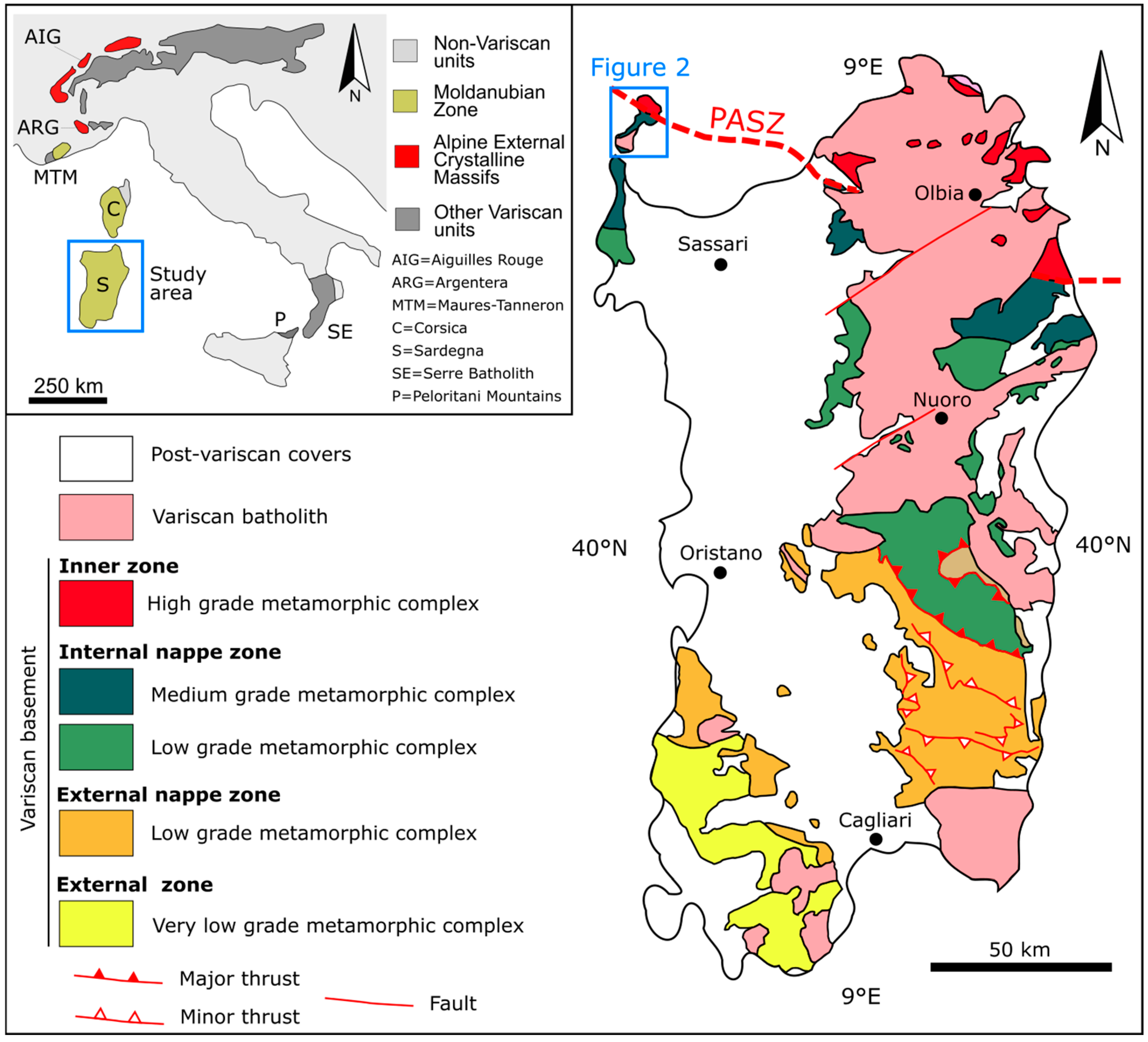
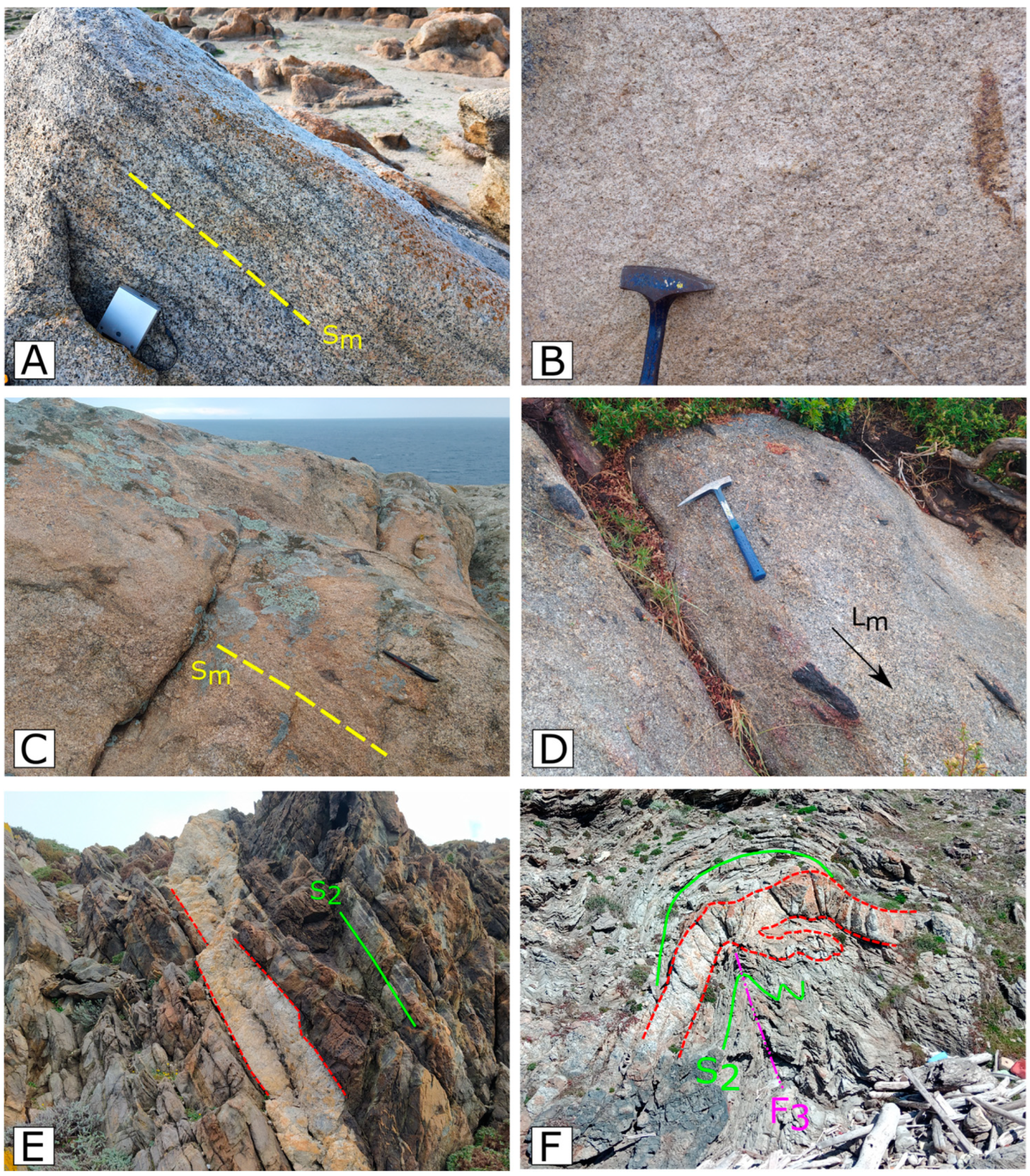

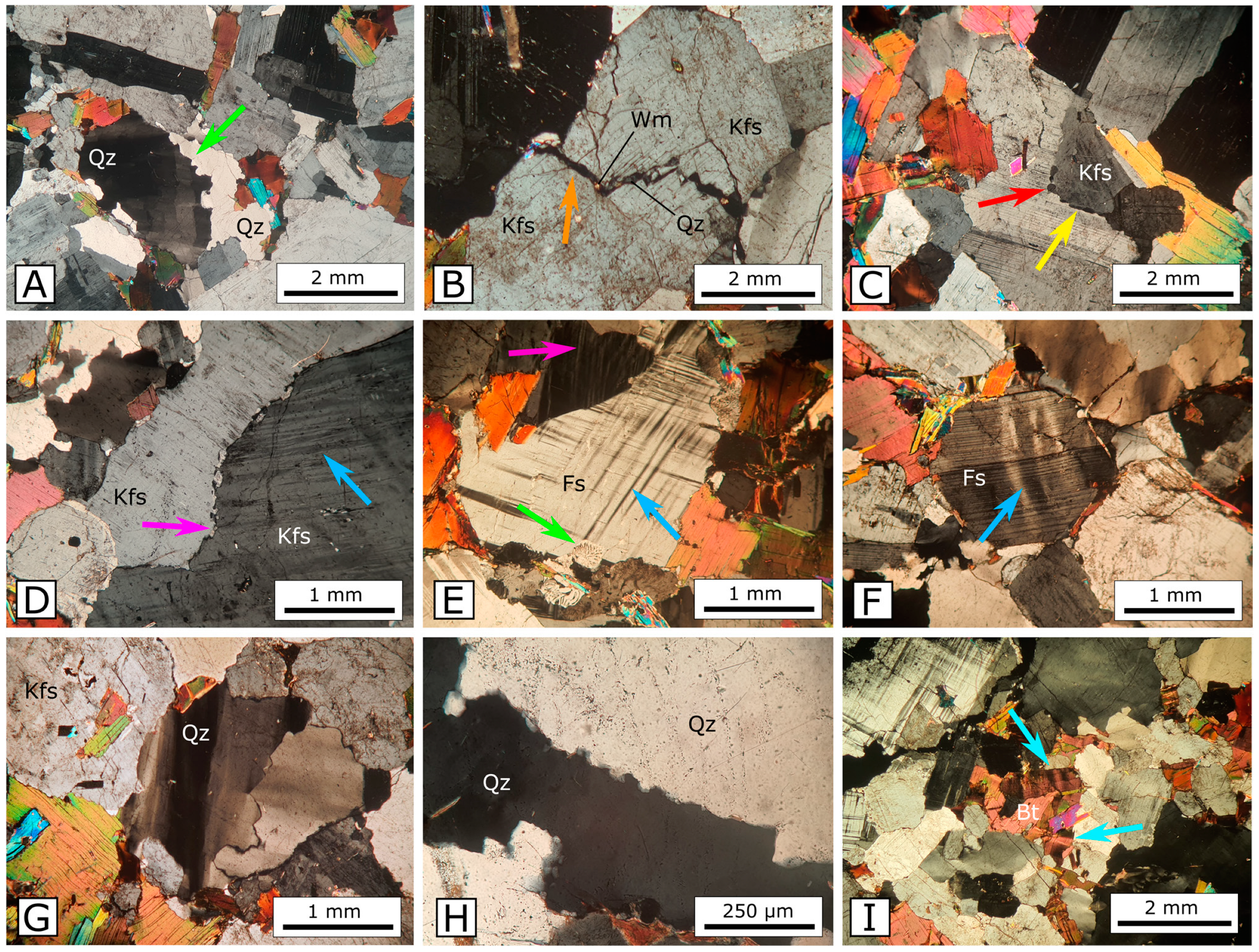
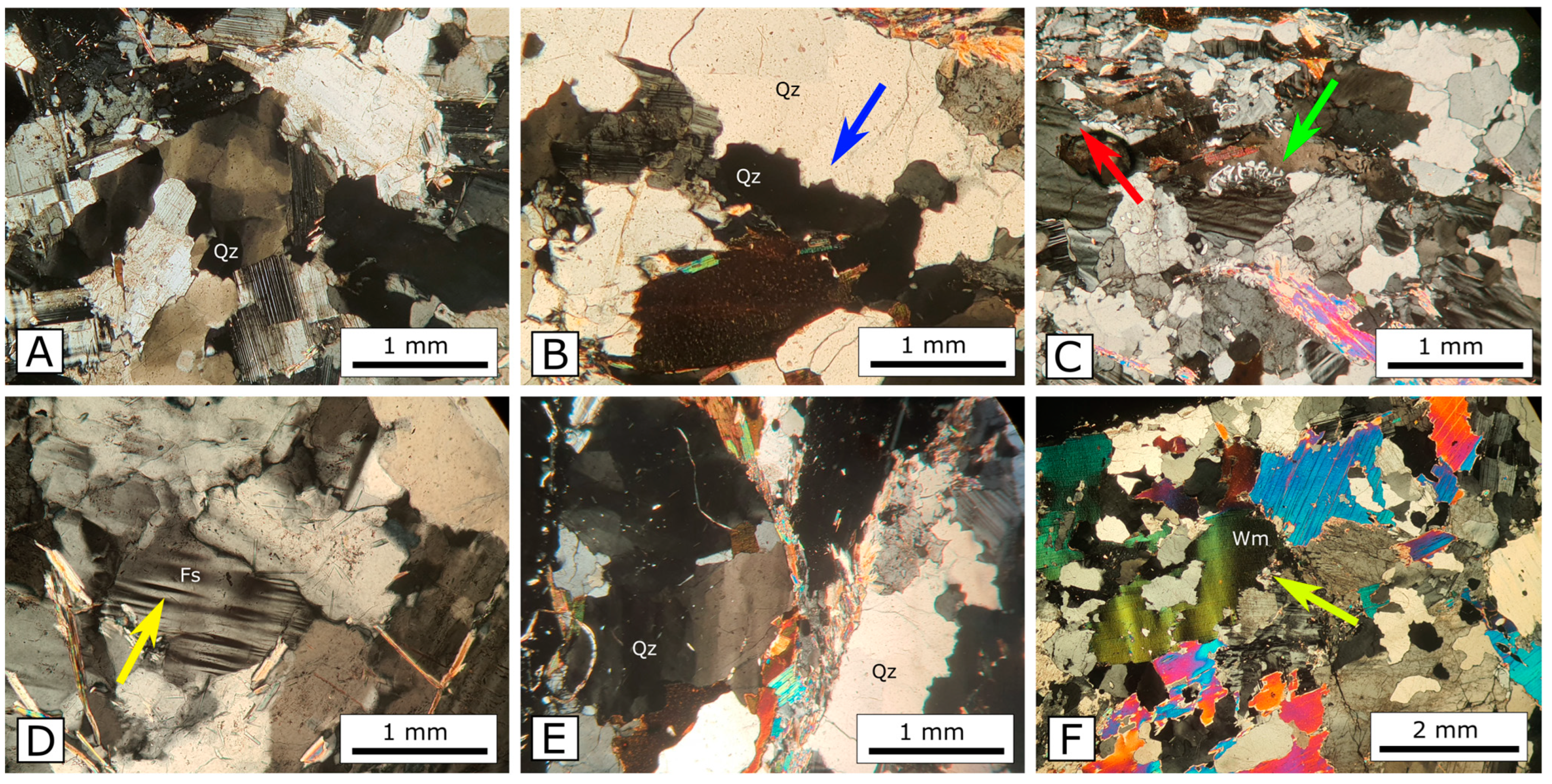
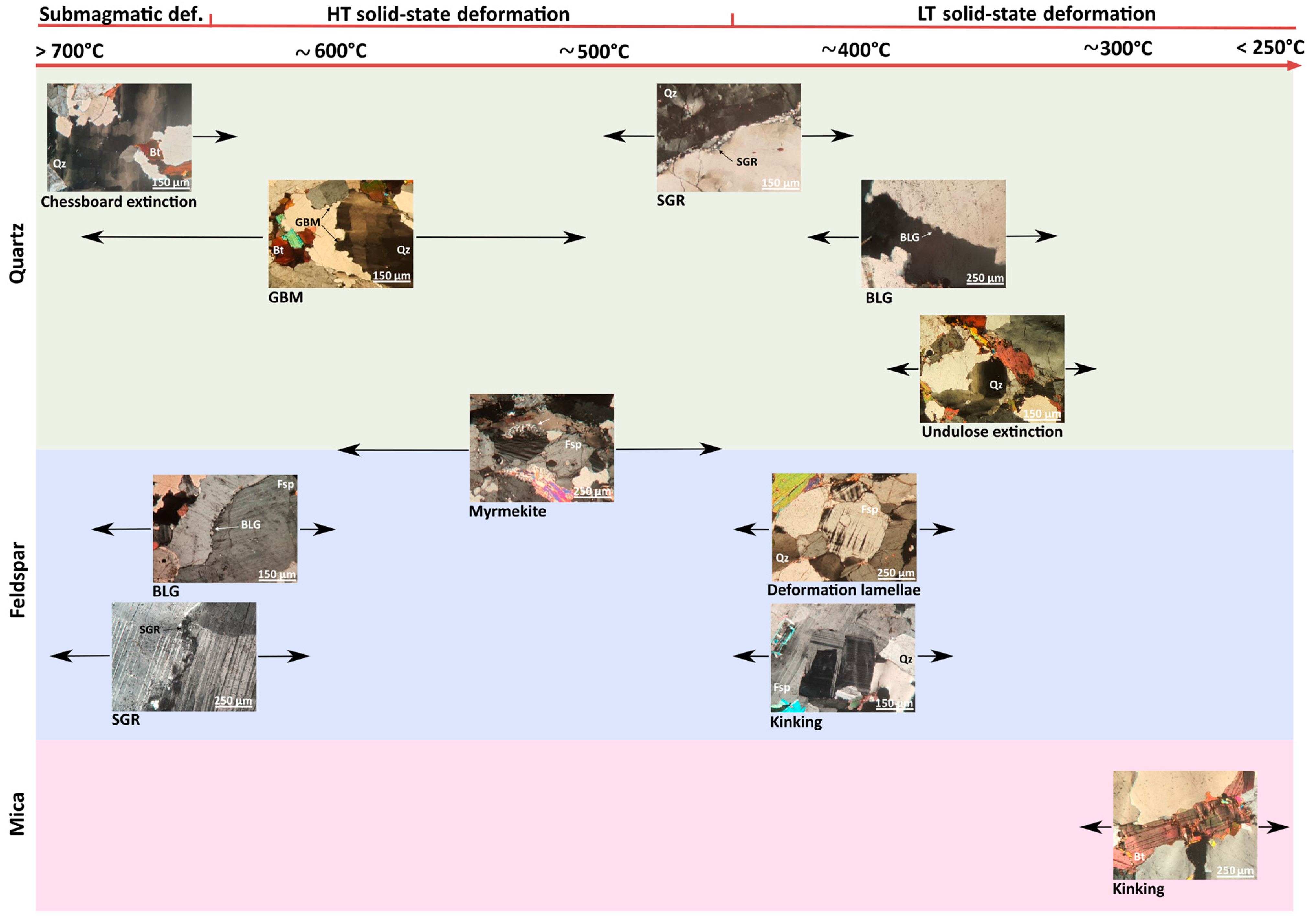
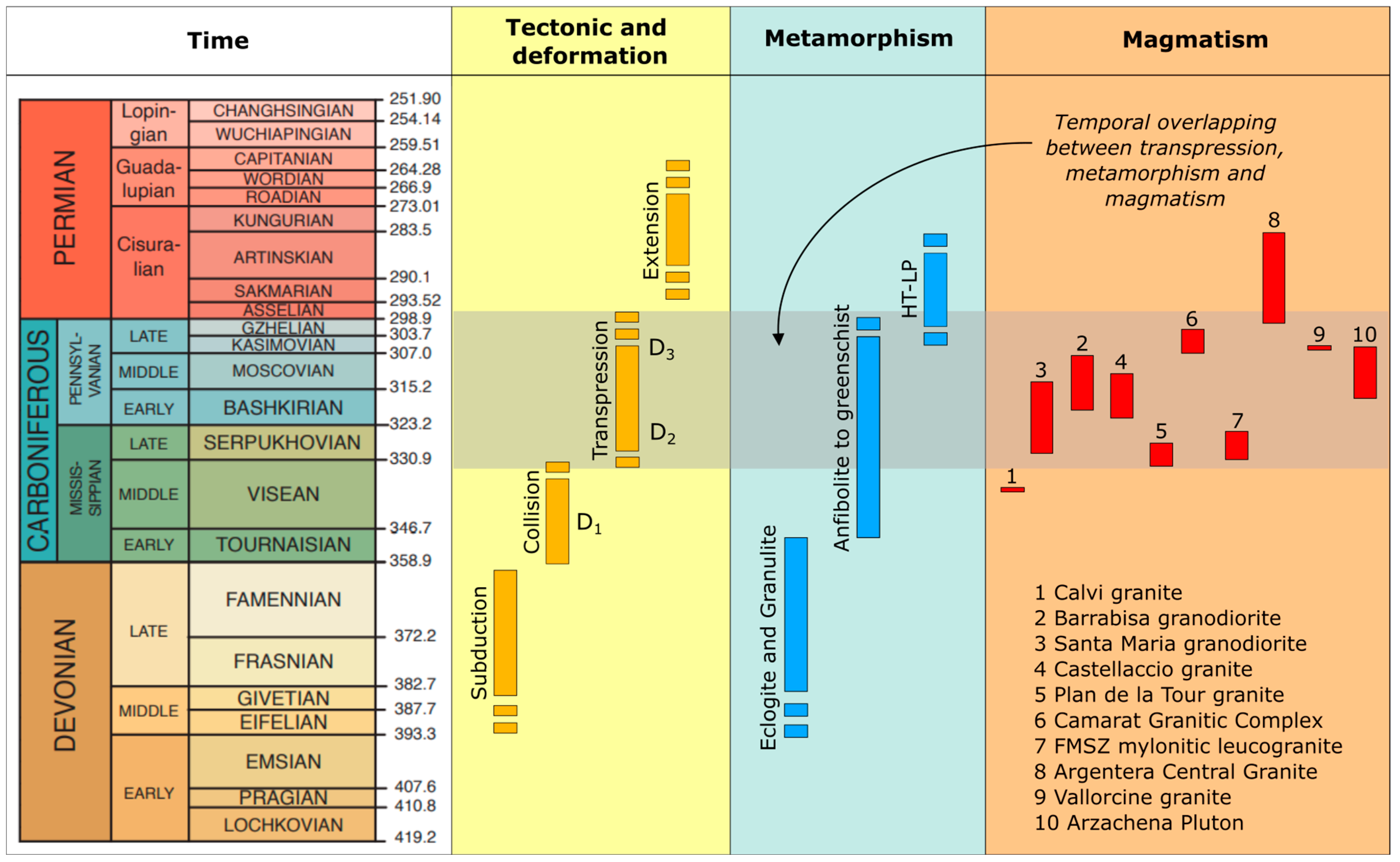
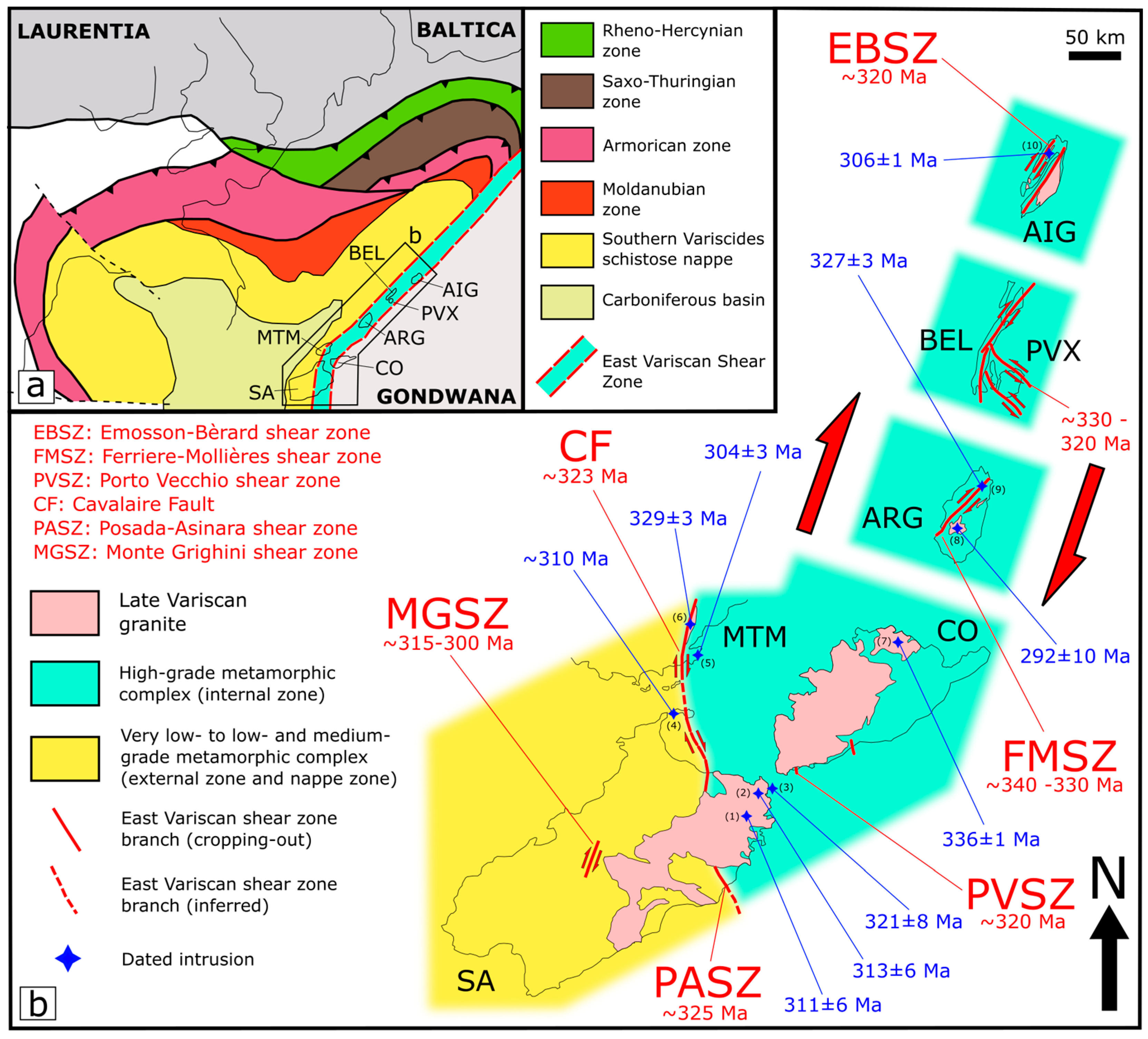

Disclaimer/Publisher’s Note: The statements, opinions and data contained in all publications are solely those of the individual author(s) and contributor(s) and not of MDPI and/or the editor(s). MDPI and/or the editor(s) disclaim responsibility for any injury to people or property resulting from any ideas, methods, instructions or products referred to in the content. |
© 2025 by the authors. Licensee MDPI, Basel, Switzerland. This article is an open access article distributed under the terms and conditions of the Creative Commons Attribution (CC BY) license (https://creativecommons.org/licenses/by/4.0/).
Share and Cite
Pieruccioni, D.; Simonetti, M.; Iaccarino, S.; Montomoli, C.; Carosi, R. Microstructural Investigation of Variscan Late-Collisional Granitoids (Asinara Island, NW Sardinia, Italy): New Insights on the Relationship Between Regional Deformation and Magma Emplacement. Geosciences 2025, 15, 108. https://doi.org/10.3390/geosciences15030108
Pieruccioni D, Simonetti M, Iaccarino S, Montomoli C, Carosi R. Microstructural Investigation of Variscan Late-Collisional Granitoids (Asinara Island, NW Sardinia, Italy): New Insights on the Relationship Between Regional Deformation and Magma Emplacement. Geosciences. 2025; 15(3):108. https://doi.org/10.3390/geosciences15030108
Chicago/Turabian StylePieruccioni, Diego, Matteo Simonetti, Salvatore Iaccarino, Chiara Montomoli, and Rodolfo Carosi. 2025. "Microstructural Investigation of Variscan Late-Collisional Granitoids (Asinara Island, NW Sardinia, Italy): New Insights on the Relationship Between Regional Deformation and Magma Emplacement" Geosciences 15, no. 3: 108. https://doi.org/10.3390/geosciences15030108
APA StylePieruccioni, D., Simonetti, M., Iaccarino, S., Montomoli, C., & Carosi, R. (2025). Microstructural Investigation of Variscan Late-Collisional Granitoids (Asinara Island, NW Sardinia, Italy): New Insights on the Relationship Between Regional Deformation and Magma Emplacement. Geosciences, 15(3), 108. https://doi.org/10.3390/geosciences15030108











